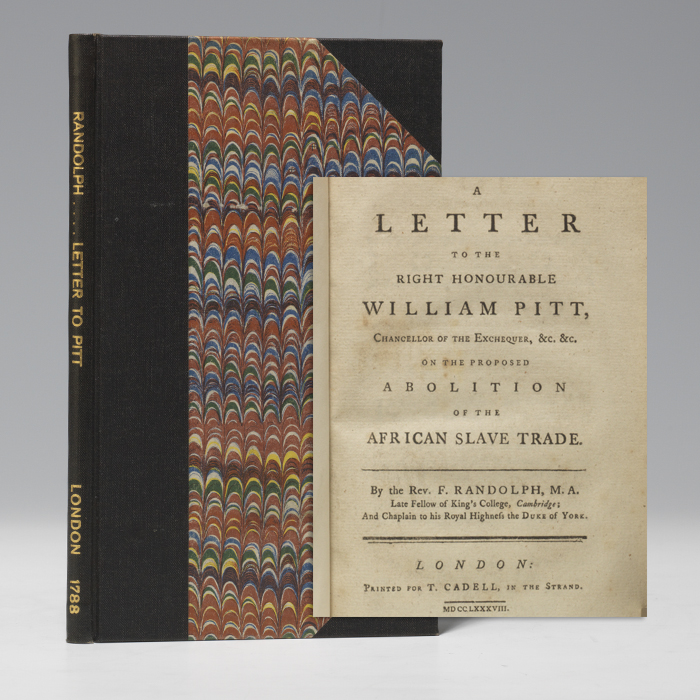
"WE CANNOT PAY THE TRIBUTE OF MERCY WITHOUT ENDANGERING THE TREASURY"
RANDOLPH, Rev. F[rancis], M.A. A Letter to the Honourable William Pitt, Chancellor of the Exchequer, &c. &c. On the Proposed Abolition of the African Slave Trade. London: T. Cadell, 1788. Slim octavo, period-style three-quarter black cloth and marbled boards; pp. 56. $1650.
First edition of Randolph’s important 1788 Letter against swift abolition of the slave trade, published the same year Prime Minister Pitt, “substituting for Wilberforce,” raised the subject in House of Commons, with Randolph instead proposing fresh regulations for slave owners and the slave trade, from the collection of the New York Historical Society.
At a time when "the British share of the European slave traffic was higher than ever," famed abolitionists Clarkson and Wilberforce worked with Prime Minister Pitt in February 1788 to create a committee of the Privy Council charged with investigating the slave trade. Three months later Pitt, "substituting for Wilberforce who was ill, introduced the subject of the trade in the House of Commons. That session passed a bill sponsored by William Dolben that regulated the dimensions of slave ships" (Rodriquez, Historical Encyclopedia I:162). Dolben's bill, known as the "Middle Passage" Bill, was passed that same July, and Pitt ordered "Captain Parrey, a naval surveyor, to take measurements of slaving vessels docked at Liverpool. Parrey came back with surveys of several ships measurements, including those of the slaver called the Brookes (or Brooks). The Society for Effecting the Abolition of the Slave Trade used the measurements of the Brookes and created the now-famous Brookes diagram" (Encyclopedia of African American History, 285).
Randolph's Letter… on the Proposed Abolition of the African Slave Trade, published soon after, is a key document in calling for restraint amidst demands for abolition of the slave trade. While Randolph praises such efforts, his Letter clearly signals the authority of those who opposed to the urgency of Pitt, Clarkson and Wilberforce. Randolph is especially mindful of how "slavery and the slave trade were tied closely to the rights of private property, the political freedom of colonies and states, and the economic rewards of international competition" (Davis, Homicide to Slavery, 244-5). He insists we cannot "pay the Tribute of Mercy without endangering the Treasury." A sympathetic reviewer observed that Randolph's Letter "inclines strongly to the cause of freedom… and since a total abolition of Negro-slavery is not likely soon to happen, he proposes a set of very proper regulations for the African trade, and for the better treatment of slaves in the plantations" (Monthly Review, May 1788, 429). By 1807, however, those who shared Randolph's views were confronted by Parliament's passage of the Slave Trade Act and the next year Clarkson's History, with its folding map of Brookes slave ship. Sabin 67823. Allibone II:1738. Hogg, African Slave Trade:155. With deaccession inkstamp of the New York Historical Society: "Withdrawn N-YHS." Faint instamp: "Bound N.Y.H.S. May 10 1943."
Text very fresh with only lightest scattered foxing. A highly desirable near-fine copy of a major work in the history of slavery.